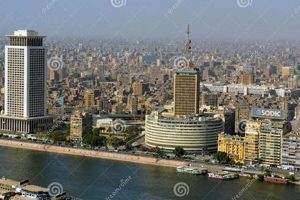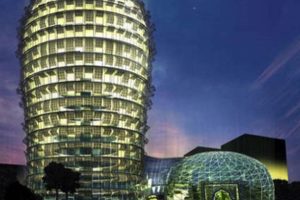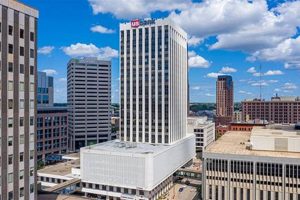Manhattan skyscrapers are towering structures that dominate the skyline of New York City. They are a symbol of the city’s financial and economic power, and their distinctive architecture has made them some of the most recognizable buildings in the world.
The first skyscrapers were built in Manhattan in the late 19th century, and they quickly became a popular way to house businesses and other organizations. The Empire State Building, constructed in 1931, was once the tallest building in the world, and it remains one of the most iconic skyscrapers in the city. Today, there are over 5,000 skyscrapers in Manhattan, making it one of the most densely populated areas of skyscrapers in the world.
Skyscrapers have had a major impact on the development of Manhattan. They have allowed the city to grow vertically, and they have helped to create a dense urban environment that is home to millions of people. Skyscrapers have also been a major source of investment for the city, and they have helped to create jobs and boost the economy.
1. Height
The height of Manhattan skyscrapers is a defining characteristic of these structures and a major contributor to their iconic status. The Empire State Building, for example, stands at 1,454 feet tall and was the tallest building in the world for over 40 years. The One World Trade Center, completed in 2014, is now the tallest building in the United States at 1,776 feet tall.
The height of Manhattan skyscrapers has been driven by a number of factors, including the city’s dense population, limited land area, and desire for prestige. Tall buildings allow for more efficient use of space and can accommodate more people and businesses in a single structure. They also provide tenants with panoramic views of the city and can be used as landmarks for navigation.
The construction of tall skyscrapers requires specialized engineering and construction techniques. The buildings must be designed to withstand high winds and seismic activity, and they must be equipped with efficient elevators and other systems to move people and materials quickly and safely.
The height of Manhattan skyscrapers has had a significant impact on the city’s development. Skyscrapers have allowed the city to grow vertically, and they have helped to create a dense urban environment that is home to millions of people. Skyscrapers have also been a major source of investment for the city, and they have helped to create jobs and boost the economy.
2. Architecture
The architecture of Manhattan skyscrapers is diverse, reflecting the different periods in which they were built and the changing tastes of architects and developers. Some of the most iconic skyscrapers in Manhattan include the Empire State Building, the Chrysler Building, and the One World Trade Center. These buildings are all examples of Art Deco architecture, which was popular in the 1920s and 1930s. Art Deco skyscrapers are characterized by their sleek lines, geometric shapes, and decorative details.
In the years after World War II, a new style of skyscraper emerged, known as Modernist architecture. Modernist skyscrapers are characterized by their simple lines, lack of ornamentation, and use of glass and steel. Some of the most famous examples of Modernist skyscrapers in Manhattan include the Seagram Building, the Lever House, and the United Nations Secretariat Building.
The diversity of architectural styles in Manhattan skyscrapers is a reflection of the city’s rich history and culture. Skyscrapers are more than just buildings; they are works of art that reflect the aspirations and values of the people who built them.
3. Materials
The use of steel and glass in the construction of skyscrapers has been a major factor in the development of Manhattan’s skyline. Steel is a strong and durable material that can be used to create tall, slender structures. Glass is a transparent material that allows natural light to enter the building, reducing the need for artificial lighting. The combination of steel and glass has allowed architects to design skyscrapers that are both aesthetically pleasing and functional.
One of the most iconic examples of a steel and glass skyscraper is the Empire State Building. Completed in 1931, the Empire State Building is one of the tallest buildings in the world and a symbol of New York City. The building’s steel frame allowed it to be built to a height of 1,454 feet, and its glass facade provides stunning views of the city.
The use of steel and glass in skyscraper construction has also had a significant impact on the city’s economy. The construction of skyscrapers has created jobs for architects, engineers, and construction workers. Skyscrapers have also attracted businesses to Manhattan, as they provide modern and efficient office space. The presence of skyscrapers has helped to make Manhattan one of the world’s leading financial and commercial centers.
The use of steel and glass in the construction of Manhattan skyscrapers is a testament to the ingenuity and creativity of architects and engineers. These buildings are a symbol of the city’s economic power and global influence.
4. Engineering
The engineering of Manhattan skyscrapers is a marvel of modern construction. These towering structures must be able to withstand high winds, earthquakes, and other natural disasters. They must also be safe for the people who live and work in them.
- Structural Engineering
Structural engineers design the framework of a skyscraper. This framework must be strong enough to support the weight of the building and its occupants, as well as the forces of wind and earthquakes. Structural engineers also design the building’s foundation, which must be able to transfer the weight of the building to the ground.
- Mechanical Engineering
Mechanical engineers design the building’s mechanical systems, including the heating, ventilation, and air conditioning (HVAC) system. They also design the building’s plumbing and electrical systems.
- Fire Protection Engineering
Fire protection engineers design the building’s fire protection systems, including the sprinkler system, fire alarms, and smoke detectors. They also develop fire escape plans and train building occupants on fire safety procedures.
- Geotechnical Engineering
Geotechnical engineers study the soil and rock conditions at the building site. They make sure that the foundat
ion of the building is strong enough to support the weight of the building and that the soil will not settle or shift over time.
The engineering of Manhattan skyscrapers is a complex and challenging task. However, it is a task that is essential to ensuring the safety of the people who live and work in these buildings.
5. Cost
The cost of constructing a skyscraper is a major factor in its development. The high cost of Manhattan skyscrapers is due to a number of factors, including the cost of land, the cost of materials, and the cost of labor.
The cost of land in Manhattan is among the highest in the world. This is due to the city’s limited land area and its high demand for space. The cost of materials has also been rising in recent years, due to the increasing cost of steel, glass, and other building materials.
The cost of labor is another major factor in the cost of constructing a skyscraper. Skyscrapers are complex structures that require a high level of skill and expertise to build. This drives up the cost of labor.
Despite the high cost of construction, skyscrapers remain an important part of the Manhattan skyline. Skyscrapers provide much-needed office space and housing for the city’s growing population. They also serve as symbols of the city’s economic power and global influence.
The high cost of Manhattan skyscrapers has a number of practical implications. First, it means that only the wealthiest developers can afford to build skyscrapers in Manhattan. This can lead to a lack of diversity in the city’s skyline. Second, the high cost of skyscrapers can make it difficult for businesses to afford to locate in Manhattan. This can lead to a loss of jobs and economic activity in the city.
Despite the challenges, the high cost of Manhattan skyscrapers is unlikely to change in the near future. The demand for space in Manhattan is simply too high, and the cost of land and materials is unlikely to decrease. As a result, skyscrapers will continue to be a major part of the Manhattan skyline for years to come.
6. Tenants
The presence of tenants is a crucial component of Manhattan skyscrapers, driving their development and shaping their impact on the city. Skyscrapers provide much-needed space for businesses and organizations to operate and grow, while also offering residential units for people to live in. This symbiotic relationship between tenants and skyscrapers has been a key factor in the development of Manhattan’s economy and its status as a global hub for commerce and culture.
The diverse range of tenants in Manhattan skyscrapers reflects the city’s diverse economy. Office space is in high demand, with many financial, legal, and technology companies headquartered in Manhattan. Retail stores line the streets, catering to the needs of both residents and tourists. And apartments provide housing for people from all walks of life, from young professionals to families to retirees.
The presence of tenants in Manhattan skyscrapers has a number of practical implications. First, it generates revenue for the owners of the buildings. This revenue can be used to maintain and improve the buildings, as well as to fund new development projects. Second, the presence of tenants creates jobs. Skyscrapers require a large number of workers to operate, including janitors, security guards, engineers, and maintenance staff. Third, the presence of tenants helps to create a vibrant and lively urban environment. Skyscrapers are often home to restaurants, cafes, and other businesses that cater to the needs of the people who work and live in them.
The connection between tenants and Manhattan skyscrapers is a mutually beneficial one. Skyscrapers provide tenants with the space they need to operate and grow, while tenants provide skyscrapers with the revenue and vitality they need to thrive. This relationship has been a key factor in the development of Manhattan into one of the world’s leading cities.
7. Impact
Skyscrapers have had a major impact on the development of Manhattan, helping to create a dense urban environment that is home to millions of people. This impact can be seen in a number of ways:
- Increased population density: Skyscrapers allow for a much higher population density than traditional low-rise buildings. This is because skyscrapers can accommodate more people on a smaller amount of land. As a result, Manhattan is one of the most densely populated areas in the United States, with over 27,000 people per square mile.
- Vertical expansion: Skyscrapers have allowed Manhattan to expand vertically, rather than horizontally. This has helped to preserve the city’s green spaces and parks, while still allowing for the construction of new buildings. Skyscrapers have also helped to create a more walkable and bikeable city, as people can easily reach their destinations without having to travel long distances.
- Economic growth: Skyscrapers have been a major driver of economic growth in Manhattan. The construction of skyscrapers has created jobs and boosted the city’s economy. Skyscrapers have also attracted businesses to Manhattan, as they provide modern and efficient office space. The presence of skyscrapers has helped to make Manhattan one of the world’s leading financial and commercial centers.
- Cultural impact: Skyscrapers have also had a major cultural impact on Manhattan. Skyscrapers are often seen as symbols of the city’s economic power and global influence. They have also been featured in numerous movies, TV shows, and other works of popular culture. Skyscrapers have helped to shape the image of Manhattan and make it one of the most recognizable cities in the world.
The impact of skyscrapers on Manhattan has been profound. Skyscrapers have helped to create a dense, vibrant, and economically prosperous city. They have also helped to shape the image of Manhattan and make it one of the most recognizable cities in the world.
8. Symbol
Skyscrapers have become synonymous with New York City, and they are often used as a symbol of the city’s economic power and global influence. This connection is due, in part, to the fact that Manhattan is home to some of the world’s most iconic skyscrapers, including the Empire State Building, the Chrysler Building, and the One World Trade Center. These buildings have been featured in countless movies, television shows, and other works of popular culture, which has helped to cement their status as symbols of New York City.
The use of skyscrapers as a symbol of New York City has a number of practical implications. First, it helps to attract tourists to the city. People from all over the world come to New York City to see its iconic skyscrapers, and this tourism revenue helps to support the city’s economy. Second, the use of skyscrapers as a symbol of New York City helps to attract businesses to the city. Businesses want to be associated with the prestige and power of New York City, and they often choose to locate their headquarters i
n the city’s skyscrapers.
The connection between skyscrapers and New York City is a mutually beneficial one. Skyscrapers provide New York City with a unique and iconic identity, and New York City provides skyscrapers with a global stage on which to be seen. This connection is likely to continue for many years to come, as skyscrapers remain a defining feature of the New York City skyline.
FAQs on Manhattan Skyscrapers
Manhattan skyscrapers are iconic structures that have shaped the city’s skyline and economy. Here are answers to some frequently asked questions about these architectural marvels:
Question 1: What is the tallest skyscraper in Manhattan?
The tallest skyscraper in Manhattan is One World Trade Center, which stands at 1,776 feet tall.
Question 2: What is the oldest skyscraper in Manhattan?
The oldest skyscraper in Manhattan is the Tower Building, which was completed in 1889 and stands at 11 stories tall.
Question 3: How many skyscrapers are there in Manhattan?
There are over 5,000 skyscrapers in Manhattan, making it one of the most densely populated areas of skyscrapers in the world.
Question 4: What are the most famous skyscrapers in Manhattan?
Some of the most famous skyscrapers in Manhattan include the Empire State Building, the Chrysler Building, the One World Trade Center, and the Bank of America Tower.
Question 5: What are the benefits of building skyscrapers?
Skyscrapers offer a number of benefits, including increased population density, vertical expansion, economic growth, and cultural impact.
Question 6: What are the challenges of building skyscrapers?
Skyscrapers pose a number of challenges, including engineering challenges, cost, and the need for specialized construction techniques.
In conclusion, Manhattan skyscrapers are remarkable structures that have played a significant role in shaping the city’s identity and economy. Their continued presence will undoubtedly contribute to the city’s growth and prosperity in the years to come.
Transition to the next article section
Tips for Manhattan Skyscrapers
Manhattan skyscrapers are architectural marvels that offer a unique combination of style, function, and engineering prowess. Here are a few tips for getting the most out of your experience with these iconic structures:
Tip 1: Visit the observation decks. Many of Manhattan’s skyscrapers offer observation decks that provide stunning views of the city. Some of the most popular observation decks include the Empire State Building, the Top of the Rock, and One World Observatory.
Tip 2: Take a skyscraper tour. Many skyscrapers offer guided tours that provide an insider’s look at these architectural wonders. Tours typically cover the history, design, and construction of the skyscraper, as well as the views from the top.
Tip 3: Attend an event at a skyscraper. Many skyscrapers host events throughout the year, such as concerts, parties, and conferences. Attending an event at a skyscraper is a great way to experience the building’s unique atmosphere and amenities.
Tip 4: Dine at a skyscraper restaurant. Many skyscrapers have restaurants that offer stunning views of the city. Dining at a skyscraper restaurant is a great way to enjoy a meal while taking in the sights of Manhattan.
Tip 5: Shop at a skyscraper mall. Many skyscrapers have shopping malls that offer a variety of retail stores and restaurants. Shopping at a skyscraper mall is a great way to combine shopping with sightseeing.
Tip 6: Stay at a skyscraper hotel. Many skyscrapers have hotels that offer luxurious accommodations and stunning views of the city. Staying at a skyscraper hotel is a great way to experience the best of Manhattan.
Tip 7: Photograph the skyscrapers. Manhattan’s skyscrapers are a popular subject for photography. Be sure to bring your camera and capture some of the city’s most iconic landmarks.
Summary: Manhattan skyscrapers are a must-see for any visitor to New York City. By following these tips, you can get the most out of your experience with these architectural wonders.
Conclusion of the article
Conclusion
Manhattan skyscrapers are more than just buildings; they are symbols of the city’s economic power, global influence, and architectural prowess. These towering structures have shaped the city’s skyline and economy, and they continue to attract people from all over the world.
The future of Manhattan skyscrapers is bright. As the city continues to grow, new and innovative skyscrapers will be built, pushing the boundaries of design and engineering. These skyscrapers will continue to be a source of pride for New Yorkers and a symbol of the city’s continued prosperity.







